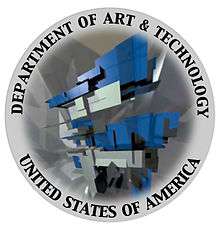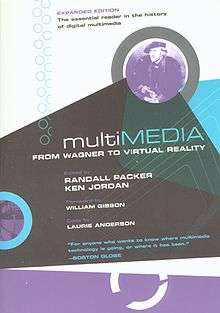Randall Packer
Randall Packer (born 1953) is an American contemporary multimedia artist.
Randall Packer | |
|---|---|
 | |
| Born | January 23, 1953 San Jose, California |
| Nationality | American |
| Education | California Institute of the Arts 1981 MFA, University of California Berkeley 1988 PhD |
| Known for | Multimedia Art, Music Composition |
Biography
Packer studied music composition with Mel Powell and Earle Brown at the California Institute of the Arts (MFA) and Richard Felciano at the University of California, Berkeley (PhD). He pursued post-graduate study in computer music in Paris, where he was a composer in residence at IRCAM (Institute for the Research and Coordination of Acoustics), Centres Georges Pompidou, under Pierre Boulez. In 1988, he founded Zakros InterArts in San Francisco, producing events and new works that explored the integration of multimedia and live performance. The first event was the San Francisco Tape Music Center Retrospective, which led to extensive research into the history of multimedia and the avant-garde. Packer continued to create new works throughout the 1990s, pioneering collaborative forms of new music theater, installation and performance art that incorporated emerging technologies in computer music, video art, and interactive art. In 1995 he became the Director of the San Francisco State University Multimedia Studies Program, located in the heart of San Francisco's Multimedia Gulch where the "Wired" generation was coming of age. In 1997 he joined the faculty of the University of California, Berkeley, and was the first to teach digital media in the Department of Art Practice. In 1999, the sound installation Mori, a collaboration with Ken Goldberg and Gregory Kuhn, debuted at the InterCommunication Center (ICC) Biennial exhibition in Tokyo, Japan. Mori later toured museums throughout the US as part of the exhibition Telematic Connections: The Virtual Embrace, organized by new media curator Steve Dietz and Independent Curators International. In 1999, his Net artwork, the Telematic Manifesto, was included in the seminal net art exhibition, Net Condition, organized by Peter Weibel at ZKM (Center for Art & Media) in Karlsruhe, Germany.
Washington, DC

In 2000 he moved to Washington, DC and began an exploration and critique of the role of the artist in society and politics. He later founded the virtual government agency, US Department of Art & Technology, and became its first Secretary. In 2000, he also joined the faculty of the Maryland Institute College of Art in Baltimore, where for three years he served as the Director of the Center for Digital Media. In 2001, after over ten years of research into the history, theory, and practice of multimedia, his seminal book, Multimedia: From Wagner to Virtual Reality, co-authored with Ken Jordan, was published by W.W. Norton with a companion Website sponsored by Intel Corporation. In 2004, in response to the Republican National Convention in New York City, he installed the Experimental Party Disinformation Center at the LUXE Gallery on 57th St. That same year he joined the faculty at American University in Washington, DC, where he taught multimedia in the Department of Art until 2009. In 2006 his music for the sound installation Mori was featured in a solo dance performed by the San Francisco Ballet at the Opera House in San Francisco. Most recently, his multimedia performance work, A Season in Hell, the culminating project of the US Department of Art & Technology, was commissioned by ZER01 and debuted at the San Jose 01SJ Biennial in September 2010.

In 2011, he began extensive research into the future of online teaching in the media arts, joining the faculty of Johns Hopkins University, where he continues to teach multimedia in the Museum Studies program. In 2012, he created Open Source Studio (OSS), an exploration of new online methodologies for teaching multimedia art. The OSS project has led to collaborative research and online courses for the California Institute of the Arts, and the School of Art, Design, and Media at Nanyang Technological University in Singapore, where he is currently Visiting Associate Professor.
Packer has received international acclaim for his multimedia and political artworks, with articles in the New York Times, Washington Post, and the San Francisco Chronicle. He has performed and exhibited at galleries, museums, theaters and festivals internationally, including ZKM (Center for Art & Media) Karlsruhe Germany, Transmediale in Berlin, Corcoran Gallery of Art in Washington DC, The Kitchen in New York City, the Oklahoma City Museum of Art, and Theater Artaud in San Francisco. His essays on art, technology, politics and culture have been published by MIT Press, the Leonardo Journal for the Arts & Sciences, LINK, ART LIES, and Cambridge University Press. His scholarly work has been incorporated into the curriculum of universities and art schools throughout the world. He is the recipient of numerous awards, including an ASCAP Prize for music composition, the George Ladd Prix de Paris from the University of California, Berkeley, three Artist Fellowships from the Washington DC Commission on the Arts & Humanities, and an Isadora Duncan Award.
External links
- Reportage from the Aesthetic Edge
- Zakros InterArts
- Multimedia: From Wagner to Virtual Reality
- Third Space Network
- US Department of Art & Technology
- Open Source Studio